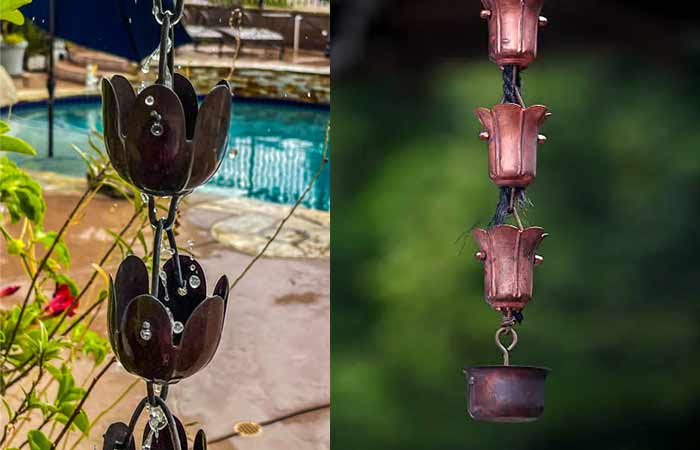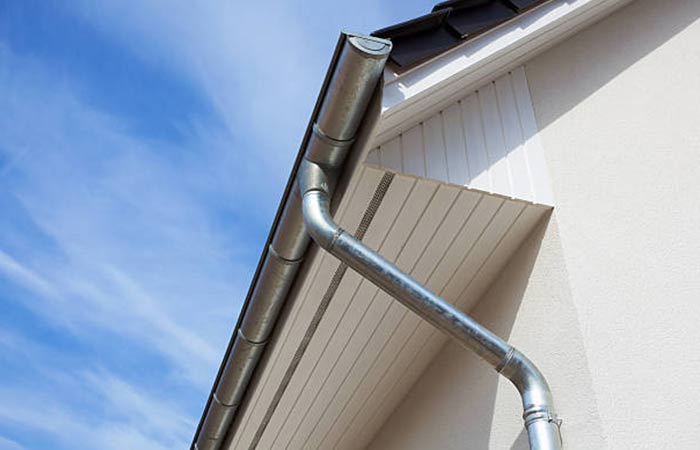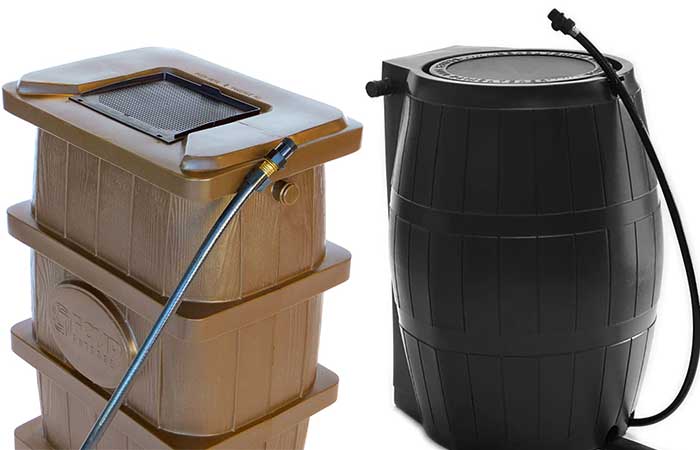While rain chains can be aesthetically pleasing and provide an alternative to traditional downspouts, there are some potential issues or challenges that you may encounter with their use. Here are common problems associated with rain chains, along with possible solutions and the top alternatives for rains chains
Insufficient Water Capacity
Rain chains generally have a lower water capacity compared to gutter downspouts. During heavy rainfall or when dealing with large volumes of water, rain chains may not be able to handle the flow adequately. This can result in overflow or inadequate drainage, potentially leading to water damage or flooding.
Solution: Consider using rain chain adapters or larger-sized cup-style rain chains with higher water capacity to handle heavy rainfall. Install multiple rain chains or use a combination of rain chains and gutter downspouts to ensure sufficient water drainage.
Splashing due to Limited Control of Water Direction
Unlike gutter downspouts that allow for controlled water direction away from specific areas, rain chains, due to their open design, have a more uncontrolled flow pattern. Rain chains can cause splashing and water dispersion near your building’s foundation which can result in water pooling in undesired locations, potentially causing damage to landscaping, structures, or walkways.
Solution: Utilize catch basins or rain barrels at the bottom of rain chains to collect water and control its dispersal. Use splash guards or diverters at the bottom of the rain chains to prevent water from splashing onto the foundation.
Incorporate decorative elements, such as rocks or pebbles, around the rain chain to help redirect water flow away from undesired areas. Extending the length of the rain chains can also help to ensure the water reaches a safe distance from the foundation
Further Reading: 13 Creative Rain Chain Drainage Ideas
Freezing in Cold Climates
In colder regions, rain chains can be prone to freezing during winter months. Ice formation on the chains can obstruct the water flow, preventing proper drainage and potentially causing damage to the rain chain or gutters. This can be especially problematic if the frozen rain chain accumulates additional ice and weight.
Solution: Choose rain chains made from materials that are less prone to freezing, such as aluminum or stainless steel. Apply de-icing products or heat tape to prevent ice formation and maintain proper water flow during freezing temperatures.
Ineffective During Intense Storms
Rain chains may not be as effective as gutter downspouts during severe storms with high wind speeds and heavy downpours. The uncontrolled flow of rainwater down the chains might struggle to handle the volume of water, potentially leading to overflow and water-related issues. This can be a concern in regions prone to intense or frequent storms.
Solution: Install additional rain chains or downspouts in areas that experience heavy rainfall to handle the increased water volume. Consider adding gutter extensions or underground drainage systems to supplement rain chains during intense storms.
Add a rain chain anchor to secure and stabilize the chain. It is important to note that rain chains are better suited for areas with mild rainfall or as decorative elements rather than practical solutions for heavy precipitation.
They can Accumulate Debris
Over time, rain chains can accumulate debris such as leaves, twigs, or dirt. This can affect how flows through them leading to clogs, hence reducing their effectiveness.
Solution: Regularly inspect and clean rain chains to remove any debris or obstructions that may impede water flow. This can be done by manually removing debris or using water pressure to flush out clogs. Install leaf guards or gutter filters to prevent debris from entering the gutter system and reduce the number of debris reaching the rain chain.
They can be Noisy
While the sound of rainwater cascading down rain chains can be pleasant and soothing for many, it may be undesirable for those who prefer a quieter environment. The sound generated by rain chains might be considered noise pollution or an annoyance, especially if the rain chain is located close to living spaces or bedrooms.
Solution: Opt for rain chains with larger cups or softer materials to minimize noise. This can help create a more soothing and quieter water flow. Position rain chains farther away from living spaces or bedrooms to reduce noise disturbance.

Limited Effectiveness in Large Structures
Rain chains may be less effective or practical for buildings with extensive roof surfaces or multiple stories. The limited capacity and uncontrolled flow of rain chains might not adequately manage the significant amount of rainwater runoff from larger structures. This could result in inadequate drainage and potential water-related issues.
Solution: Install a combination of rain chains and gutter downspouts to handle the larger roof surfaces and water volume effectively. Ensure proper positioning of rain chains and downspouts at different locations on the building to distribute water drainage evenly.
Installation and Compatibility Challenges
Installing rain chains requires careful consideration and proper attachment to the roof’s eaves or gutter system. Ensuring compatibility with the existing gutters and roof structure is essential to prevent issues such as leaks, improper water flow, or instability. Improper installation can lead to water leakage, damage to the roof or gutters, and diminished functionality of the rain chain system.
Solution: Consult with professionals or experienced installers to ensure proper installation of rain chains, taking into account compatibility with existing gutters and roof structures. Conduct regular inspections to identify any installation issues or signs of damage and promptly address them.
Inefficient Water Collection for Rainwater Harvesting
Rain chains, while aesthetically pleasing, can be inefficient when it comes to collecting rainwater for harvesting purposes. Unlike traditional gutter systems that are designed to efficiently direct water into collection barrels or tanks, rain chains often result in water splashing and dispersing in different directions.
This makes it challenging to effectively capture and store the water for future use.
Solution: Consider alternative options that offer better water management capabilities. Shortly coming up.
Heavy Chains can be Destructive
Some rain chains are made with heavy or large metal links or cups. In areas prone to high winds or severe weather conditions, these heavy components could pose a risk of damage to the rain chain itself, as well as to the gutters or surrounding structures. The weight and movement of the rain chain during storms could lead to bending, breaking, or even causing damage upon impact.
Solution: Select rain chains made from lightweight materials or designs that reduce the risk of damage during severe weather conditions. Secure rain chains firmly to prevent excessive swinging or movement during storms.
Potential Damage Caused by Rain Chains
Rain chains have the potential to cause damage such as erosion and soil displacement, foundation damage, and water pooling due to their redirection of water from gutters directly to the ground.
Erosion and soil displacement
Erosion and soil displacement are potential problems that can occur when using rain chains. As the water cascades down the chain, it can create a powerful flow that may wash away topsoil and cause erosion in your yard or garden.
This can be especially concerning if you have plants or delicate landscaping near the area where the rain chain is installed. Additionally, if the water from the rain chain is not properly directed away from your home’s foundation, it can lead to soil displacement around the base of your house.
Over time, this could potentially cause damage to your foundation and compromise its stability. It’s important to consider these factors when deciding whether or not to use rain chains and take steps to mitigate any potential issues.
Foundation damage
Rain chains can potentially cause foundation damage if not properly installed or maintained. When water cascades down a rain chain, it can create excessive moisture around the base of your home, which can seep into the soil and affect the stability of your foundation over time.
This can lead to cracks, shifting, and other structural issues that may be costly to repair. To minimize the risk of foundation damage, it’s crucial to ensure proper drainage away from your home’s foundation by using extensions or splash blocks at the end of the rain chain to redirect water flow away from vulnerable areas.
Regular inspections and maintenance are also essential to identify any potential issues early on.
Water pooling
Water pooling is a common problem associated with rain chains. When rainwater flows down the chain, it can accumulate at the bottom, creating small puddles. This can be problematic as standing water promotes the growth of algae and mosquitos, posing potential health risks.
Additionally, if the puddles are not properly drained or absorbed by the soil, they can lead to erosion and damage to surrounding landscaping. To mitigate water pooling issues, it is important to ensure proper drainage mechanisms are in place and that there is sufficient absorption capacity in the ground where rainwater collects at the base of the rain chain.
Further Reading: How to Properly Install A Rain Chain
Alternatives to Rain Chains
There are several alternatives to rain chains that can offer better water management and drainage solutions. Traditional gutter systems, downspouts with splash blocks, rainwater collection barrels or tanks, and permeable surfaces are all viable options to consider.
Traditional gutter systems
Traditional gutter systems are a popular choice for managing water runoff from roofs. Here are some key features and benefits of traditional gutter systems:
- Traditional gutters are designed to efficiently collect rainwater from the roof and direct it away from the house. They help prevent water pooling and potential damage to the foundation.
- Seamless gutters are custom-made to fit the exact dimensions of your roofline, minimizing joints and potential leaks. This design reduces the risk of water seepage and ensures optimal performance.
- Traditional gutters can be professionally installed by experienced contractors or DIY enthusiasts. With proper installation, they provide a secure and reliable solution for diverting rainwater.
- Traditional gutter systems work seamlessly with downspouts to ensure proper water flow away from the house. Downspouts can be strategically placed to direct water into drainage systems or rain barrels for eco-friendly rainwater harvesting.

Further Reading:
- Rain Chains vs. Gutter Downspouts
- How to Use Rain Chains WITHOUT Gutters
- When are Important and When are they NOT Necessary
Downspouts with splash blocks
Downspouts with splash blocks are a popular alternative to rain chains when it comes to managing water flow from the roof. Unlike rain chains, which can create heavy splashes and small puddles as water flows down, downspouts with splash blocks redirect water more efficiently.
The splash block is placed at the end of the downspout to disperse the force of the water and prevent erosion or soil displacement. This solution helps control where the water goes and avoids potential damage to your foundation by directing it away from your home’s base.
Additionally, installing downspouts with splash blocks is relatively simple and doesn’t require frequent maintenance like rain chains do.
Rainwater collection barrels or tanks
Rainwater collection barrels or tanks are a practical alternative to rain chains for those looking to harvest and utilize rainwater effectively. Here are some advantages of using rainwater collection barrels or tanks:
- Rainwater collection barrels or tanks help conserve water by capturing and storing rainwater that would otherwise be wasted.
- The collected rainwater can be used for watering plants, gardens, and lawns, promoting sustainability and reducing reliance on municipal water sources.
- Using collected rainwater can help reduce water bills since it is a free resource readily available during rainy seasons.
- By collecting rainwater, you contribute to mitigating stormwater runoff, which can carry pollutants into streams, rivers, and other bodies of water.
- Rainwater collection barrels or tanks can be easily installed near downspouts or gutters with minimal effort and expertise required.
- There is a wide range of rainwater collection barrels or tanks available in different sizes and styles to suit individual needs and preferences.
- The collected rainwater can also be used for non-potable applications such as washing cars, outdoor cleaning, and even flushing toilets with the right filtration system in place.
- Having a reserve of stored rainwater provides an emergency water supply during droughts or periods of water scarcity.
- By capturing rainwater before it reaches the ground, you minimize soil erosion caused by heavy rainfall.

Permeable surfaces for improved drainage
Permeable surfaces, such as gravel or permeable pavers, offer a solution for improved drainage when rain chains may not be suitable. Unlike traditional hard surfaces like concrete or asphalt, permeable surfaces allow rainwater to seep through the material and into the ground, reducing the risk of water pooling or flooding.
These surfaces can help prevent erosion and soil displacement by allowing water to naturally infiltrate the soil below. Additionally, permeable surfaces promote healthier plant growth by providing adequate moisture while avoiding oversaturation. By incorporating permeable surfaces into your landscape design, you can effectively manage rainwater runoff without relying solely on rain chains or gutters.
More on Rain Chains
- How to Choose the Best Modern Rain Chain- Key Factors+ Top-Selling Options
- How to Make DIY Rain Chains + Ideas for Unique Designs
As an Amazon Associate, we earn from qualifying purchases. Details here
